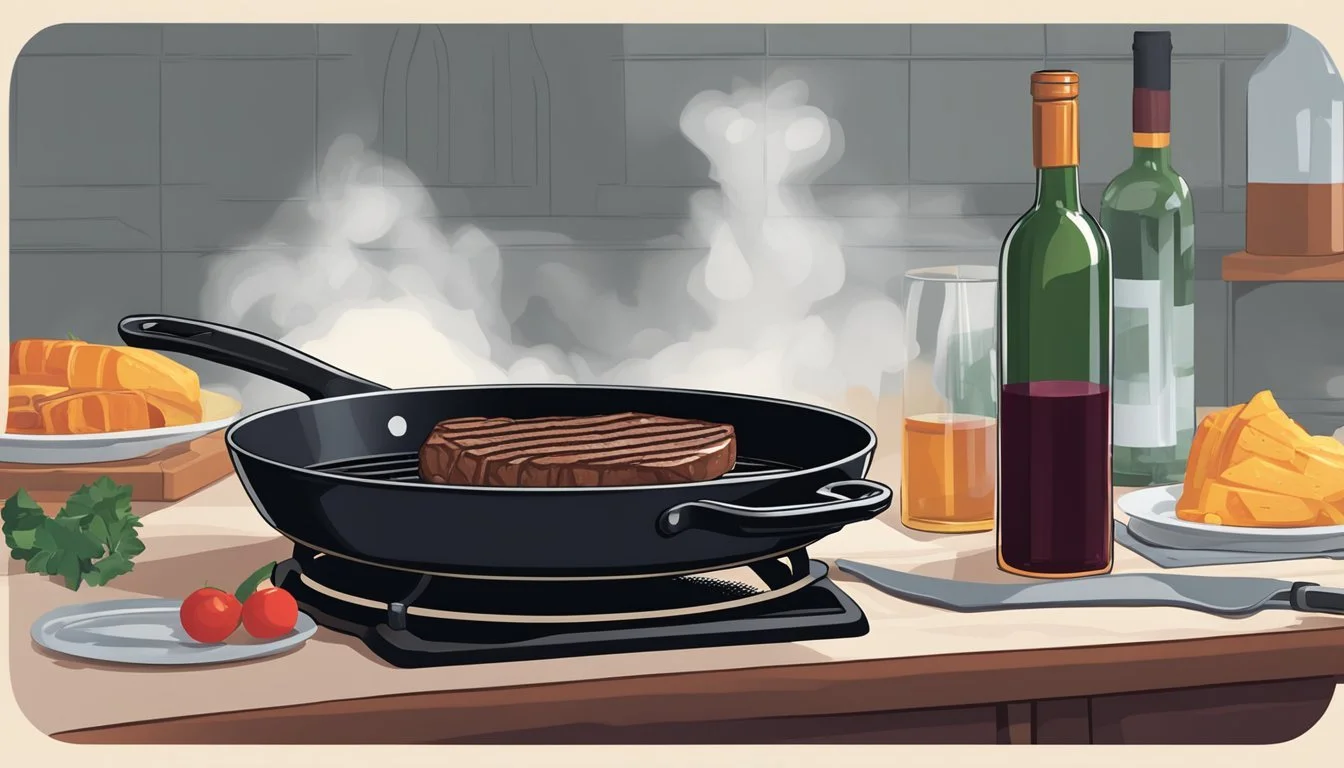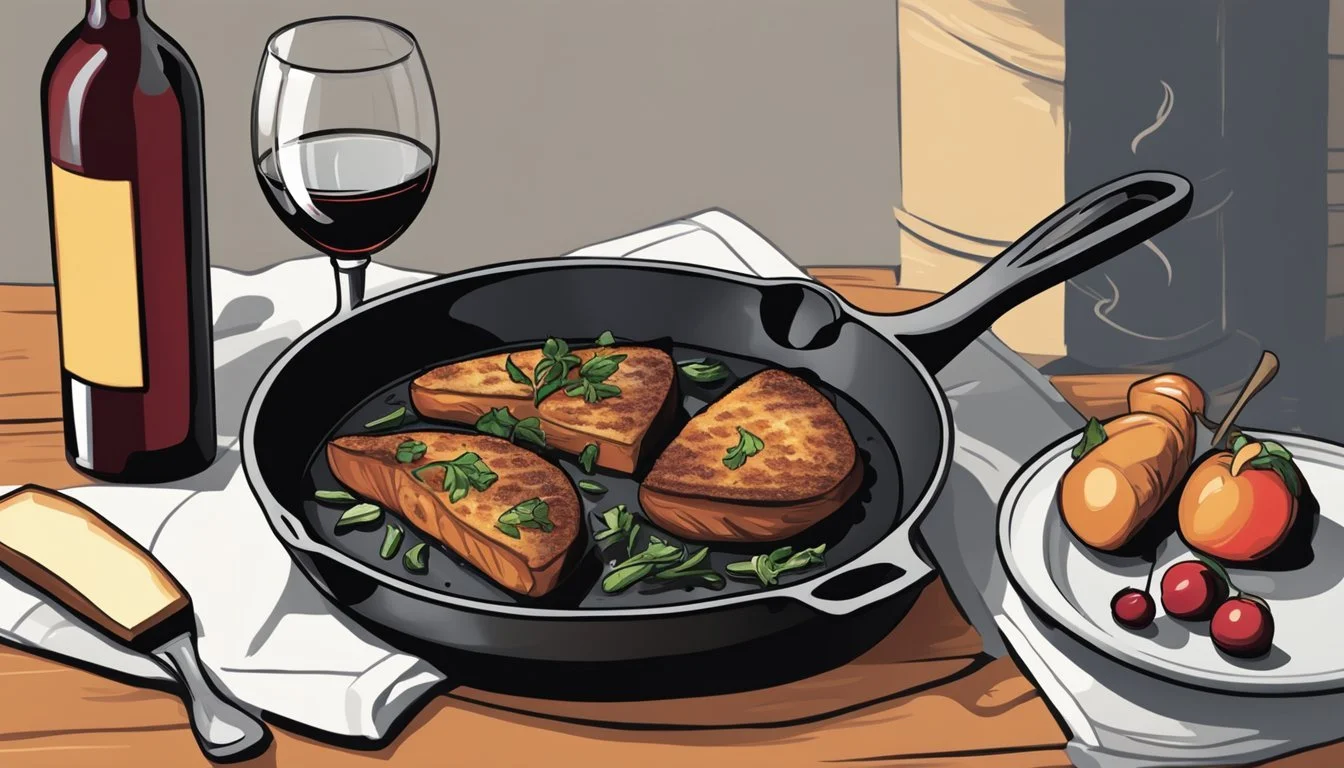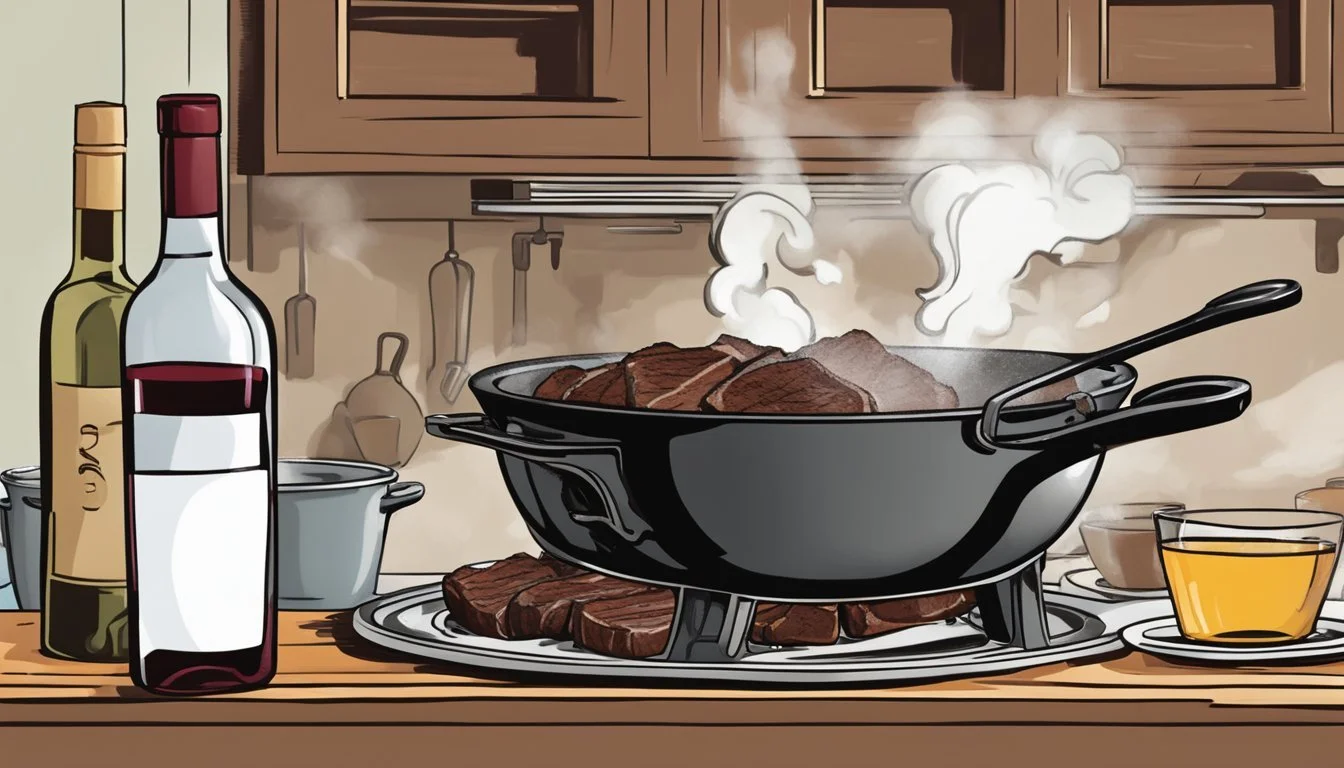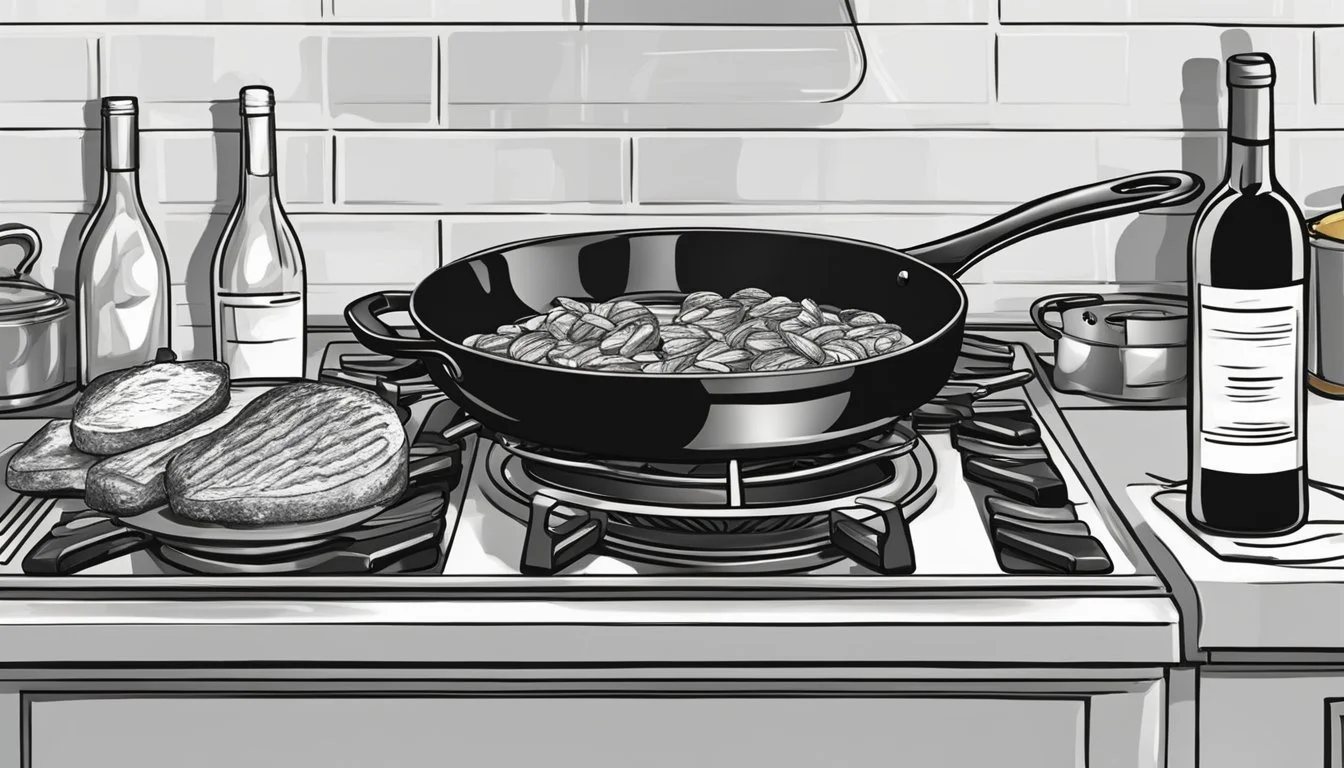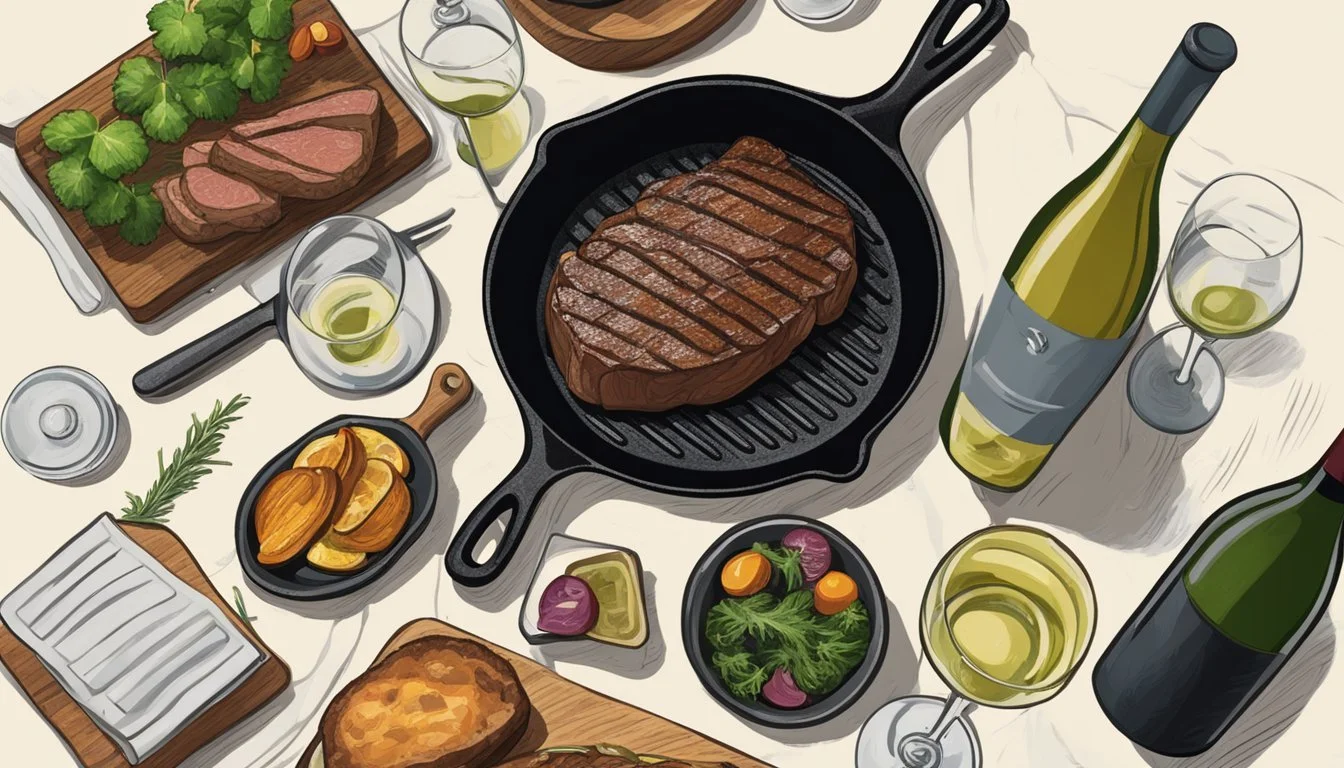Pairing Wines with Cast Iron-Cooked Meals
Enhancing the Rustic Flavors
The timeless cast iron skillet has long been treasured for its versatility and ability to retain and evenly distribute heat. Whether searing a steak to perfection or baking a sumptuous skillet brownie, this kitchen mainstay excels in delivering incomparably flavorful dishes. Pairing wines with these robust and hearty cast iron-cooked meals (how long do cooked meals last?), however, requires a certain finesse. Recognizing the synergy between the complexity of flavors developed in cast iron cooking and the bouquet of a well-selected wine can elevate a simple meal to a gastronomic experience.
Wine pairing is both an art and a science, aiming to complement or contrast flavors in a dish. Cast iron's characteristic browning, often achieved through the Maillard reaction, imparts a deep, savory quality to dishes such as skillet-seared meats (What wine goes well with red meat?) and barbecue chicken legs, demanding a wine with sufficient body and acidity to balance the meal. Similarly, the rich, caramelized crust of cornbread baked in a cast iron skillet calls for a wine that can cut through the dish's density without overwhelming its subtle sweetness.
Understanding the nuances of cast iron cooking—from its heat-retention properties to the specific dishes it excels in preparing—is crucial when selecting a wine. Acidity in wine, for instance, provides a palate-cleansing effect that can enhance the enjoyment of heavier dishes by slicing through the fat and richness. This principle is vital in creating the perfect match, ensuring that each sip refreshes the palate and prepares it for the next delectable bite.
Pairing wines with cast iron-cooked meals can elevate your dining experience to new heights, creating a harmonious fusion of flavors that tantalize the palate. Whether you're using cast iron induction cookware or embracing the art of seasonal cast iron cooking, understanding the science of cast iron cooking can help you craft dishes that perfectly complement your chosen wine.
For a hearty and flavorful cast iron burger, consider a robust red wine like a Malbec or a Zinfandel to enhance the rich, savory notes of the dish. If you're starting your day with a sumptuous cast iron breakfast, a crisp glass of Chardonnay or a sparkling Prosecco can provide a delightful contrast to the savory and comforting flavors.
The versatility of cast iron cookware allows for a wide range of dishes, from reinvented traditional cast iron dishes to innovative culinary creations, and the right wine pairing can enhance the dining experience. Additionally, the act of preparing meals with cast iron can be a form of cast iron cooking fitness, as it involves hands-on cooking and the creation of wholesome, delicious dishes.
So, whether you're savoring a classic recipe or experimenting with something new, the art of pairing wines with cast iron-cooked meals promises to enrich your dining experience and create memorable moments around the table.
Understanding Cast Iron Cooking
When one cooks with cast iron, they're embracing a traditional method renowned for its versatility and durability. Cast iron skillets and pans are lauded for their ability to retain high heat, making them ideal for achieving a perfect sear on meats and vegetables. They can be used on the stovetop or in the oven, transitioning seamlessly between various cooking mediums.
Cookware made of cast iron necessitates regular seasoning, a process that involves coating the pan with oil and heating it to form a protective layer. This layer not only imparts a non-stick quality but also enhances flavor over time. To maintain it, one should avoid washing the cookware with harsh detergents and prevent cooking acidic foods for extended periods, as they can strip the seasoning.
Here's a summary of understanding cast iron cooking basics:
Heat Retention: Perfect for recipes requiring consistent high temperatures.
Versatility: Suitable for oven and stovetop, including induction cooktops.
Seasoning:
Purpose: Creates a natural non-stick surface and adds flavor.
Maintenance: Oil and heat to upkeep; avoid acidic foods as they may erode seasoning.
To cook with cast iron, beginning with a medium heat to warm up the pan is advisable to ensure even heating before gradually increasing to the desired temperature. These cookware pieces excel in cooking a variety of foods, from crusty bread to succulent roasted meats, while the need for maintenance and care fosters a connection between the chef and their tools, enriching the culinary experience.
The Basics of Cooking Steak
Cooking steak requires attention to detail from selection to sear, ensuring flavor and doneness are to preference. The process involves choosing the right cut, seasoning generously, and utilizing precise cooking techniques to achieve a mouthwatering meal.
Choosing the Right Steak
Selecting the proper cut of steak is crucial. Fattier steaks like ribeye bring rich flavors, while lean cuts like sirloin offer a more subtle taste. For a balanced option, a New York Strip provides tenderness and flavor. Before cooking, bringing the steak to room temperature ensures even cooking.
Preparation and Seasoning
Prior to cooking, pat the steak dry and season it. Kosher salt and freshly ground black pepper are essentials. One may also consider enhancing flavor with herbs like rosemary or thyme. Generously seasoning the meat at least 40 minutes before cooking allows the salt to penetrate and improve flavor and texture.
Cooking Techniques
When it's time to cook, heat a cast-iron skillet over high heat and coat lightly with oil to prevent sticking. Searing the steak on each side creates a delicious crust. A meat thermometer is a reliable tool to check for internal temperature corresponding to the desired doneness. After searing, some may choose to baste the steak with butter and herbs to further impart flavor. Allow the steak to rest before serving to redistribute juices.
Complementary Sides for Cast Iron Meals
Choosing the right side dishes can elevate a cast-iron cooked meal from good to great. The key is to select sides that complement the rich flavors and textures of the main dish, ensuring a well-rounded meal.
Vegetable Pairings
Cast-iron cooking brings out the natural sweetness in vegetables, making them ideal companions. For instance, asparagus sautéed in a bit of olive oil with garlic, salt, and pepper is a classic pairing. The garlic provides a pungent contrast to the asparagus' earthy flavor. Another excellent choice is broccoli, which can be roasted to perfection in a cast-iron skillet, tossed with garlic and a sprinkle of red pepper flakes for heat.
Asparagus Pairing:
Sauté with garlic, salt, and pepper
Drizzle with olive oil and roast until tender
Broccoli Pairing:
Roast with garlic and red pepper flakes
Toss until crunchy and brightly colored
Starch Pairings
The rusticity of cast-iron meals pairs splendidly with starches. Potatoes, for example, can be sliced thinly, layered in the skillet with rosemary and thyme, and roasted to make a crispy yet tender side dish. For an aromatic twist, add a hint of garlic and a generous amount of butter for richness. Additionally, a simple salad dressed with a tangy vinaigrette can cut through the heaviness of starches, adding a refreshing note to the palette.
Potato Pairing:
Layer thinly-sliced potatoes with rosemary and thyme
Add garlic and butter, bake until golden
Salad Pairing:
Mix greens with a simple vinaigrette
Partner with a roasted starch for balance
Mastering Wine Pairing
When cooking with cast iron, the heat retention and even temperature distribution highlight the flavors in your dishes. A well-selected wine can complement these intensified flavors, particularly when it comes to red meats and poultry or seafood. Understanding the relationship between the dish's flavor profile and the characteristics of the wine is key.
Pairing with Red Meat
For red meats, it’s critical to consider the boldness of both the food and the wine. Red wines with high tannin levels, like Cabernet Sauvignon, are excellent for pairing with steaks and other red meats cooked in cast iron skillets. The high heat of the cast iron creates caramelization and a robust flavor profile, which is balanced by the structure and dry sensation from the tannins.
Cast Iron Red Meat Dish Suggested Red Wine Pairing Cast Iron Ribeye Steak (What wine goes well with ribeye steak?) Cabernet Sauvignon Cast Iron Lamb Chops (What wine goes well with lamb chops?) Syrah Seared Duck Breast Pinot Noir
Pairing with Poultry and Seafood
Poultry and seafood often have lighter flavors and benefit from wines that won’t overpower them. For poultry, a medium-bodied red, such as Pinot Noir, offers a balance that compliments without dominating. A Chardonnay, particularly one that is not overly oaked, can enhance the delicate flavors of seafood while maintaining the intended texture and temperature nuances achieved through cast iron cooking.
Cast Iron Poultry & Seafood Dish Suggested Wine Pairing Cast Iron Roast Chicken Pinot Noir Cast Iron Shrimp Scampi (What wine goes well with shrimp scampi?) Sauvignon Blanc Pan-Seared Salmon Chardonnay
Finishing Touches to Enhance Flavor
When cooking with cast iron, the enhancement of flavor in the final dish can be significantly influenced by resting the meal and by using the right herb butters or oils.
Resting and Serving Steak
Resting a steak after it has been cooked in a cast iron skillet and before serving is critical. It allows the juices to redistribute evenly, resulting in a steak that is more juicy and tender. The ideal resting time depends on the steak's size, but a general rule is to let it rest for at least half the time it was cooked. The steak should be served at the proper doneness level, whether that's medium rare, medium well, or well done. This will affect the overall flavor and texture of the meat.
Resting Time:
Small steaks (1 inch or less): 5-7 minutes
Large steaks: Up to 10 minutes
Doneness Temperatures:
Medium Rare: 130-135°F (55-57°C)
Medium Well: 150-155°F (65-68°C)
Well Done: 160°F (71°C) and above
Herb Butters and Oils
Adding herb butter or high-quality oils like olive oil or avocado oil can dramatically enhance the flavor of a cast iron-cooked meal. A dollop of herb butter melting over a hot steak can bring forward the flavors provided by the marbling and the cast iron's searing capability. Use unsalted butter mixed with freshly chopped herbs for a vibrant and balanced finish. When choosing oils, opt for those that can withstand high heat, such as avocado oil, to ensure that they do not break down and affect the flavor profile of the dish.
Herb Butter:
Mix unsalted butter with herbs such as thyme, rosemary, or parsley.
Oils for Cooking:
Avocado oil: High smoke point, neutral taste.
Olive oil: Medium smoke point, rich flavor.
Care and Maintenance of Cast Iron Cookware
Maintaining cast iron cookware is crucial for its longevity and performance. Proper care includes cleaning, seasoning, and regular maintenance. Here are key pointers for keeping your cast iron in top shape.
Seasoning: Seasoning is the process of baking oil into the cookware to create a natural, non-stick surface.
Clean the cookware thoroughly.
Rub a thin layer of vegetable oil or melted shortening over the entire surface, including the outside and the handle.
Place upside down in an oven preheated to 300–350 degrees Fahrenheit, placing a sheet of aluminum foil below to catch drips.
Bake for one hour, then let it cool in the oven.
Cleaning: After cooking, allow the cookware to slightly cool down before washing.
Use warm water and a brush or sponge to clean the surface. Avoid using soap as it can strip the seasoning.
For stubborn food remnants, a paste of coarse kosher salt and water can act as an effective scrub without damaging the seasoning.
Maintenance: Routine maintenance keeps cast iron cookware in optimal condition.
After each wash, dry the cookware completely to prevent rust.
Apply a light coat of oil with a paper towel to restore the sheen, ensuring there's no excess that could turn rancid.
Store in a dry place.
Avoidance of Smoke: Excess oil can burn and smoke at high temperatures. It’s important to apply only a thin layer after cleaning and to cook at appropriate heat levels to prevent smoking.
By adhering to these guidelines, chefs can protect their investments and ensure that the flavors of their meals are enhanced and not compromised by the cookware.
Health and Nutrition Considerations
When pairing wines with cast iron-cooked meals, one must consider the nutritional aspects of both the food and the accompanying beverage. Cooking with cast iron is noted for its ability to retain heat efficiently, ensuring that foods reach and maintain the desired temperature, which is crucial for both safety and quality. It is advisable to invest in a reliable thermometer to monitor the temperature, ensuring that meat reaches the appropriate internal temperature and that juices run clear.
Calories in wine can add up, so selecting wines that complement the richness of cast iron-cooked dishes without overburdening the caloric intake is important. A glass of wine can range from 100 to 300 calories, with lighter options being more diet-friendly.
The nutritional benefits of cooking with cast iron should not be overlooked. It can fortify food with iron, an essential mineral, especially beneficial in an American diet where iron deficiencies are common. However, the iron content will vary depending on the food's acidity, moisture level, and cooking duration.
Cast iron cooking often requires less oil, contributing to a healthier meal preparation by potentially lowering fat intake. Furthermore, the even heat distribution allows for a better sear, locking in natural juices and flavors without the need for excessive seasoning or marinades.
When considering water content, cast iron efficiently evaporates excess moisture, resulting in concentrated flavors and nutrients. This is particularly relevant for vegetable-centric dishes where water-soluble vitamins are retained more effectively.
Resting your meat after cooking is also beneficial; it allows the redistribution and reabsorption of juices, essential for a delicious and nutritionally optimal meal.
Pairing wine with food is often seen as a complex course, but it can be made simple by understanding the basic principles of matching the body and flavor profile of the wine to the richness and taste of the dish.
Lastly, regarding nutrition, one should aim for balance. A full-bodied red wine might pair well with a hearty cast iron steak but opt for a lighter white wine for a simple vegetable sauté to avoid overshadowing the dish's natural flavors.
Recipe Ideas and Inspiration
This section offers a diverse range of cast iron-cooked meal ideas that pair wonderfully with wines, highlighting the essentials of preparation and flavor profiles that can enhance any dining experience.
Classic Cast Iron Steak
A sumptuous Classic Cast Iron Steak requires little more than a quality cut of beef, such as a ribeye or New York strip, seasoned with salt and cracked black pepper. Preheat the cast iron skillet to achieve a perfect sear. The total time for cooking a steak to medium-rare is typically around 10 to 12 minutes, including prep time. Serve it as the main course with a robust red wine.
Signature Chicken Dishes
Chicken dishes in cast iron deliver a deep flavor, rendered perfectly in recipes like Sumac, Wine and Lemon Skillet Chicken. Begin with a prep time of about 10 minutes, marinating the chicken in sumac, garlic, and olive oil. The cook time may range from 25 to 30 minutes until the chicken is well-browned and cooked through. A white wine with citrus notes is ideal for these dishes.
Innovative Vegetarian Recipes
One can indulge in Innovative Vegetarian Recipes loaded with vegetables and flavor. Ingredients like tofu, zucchini noodles, and a mix of bright spices turn staples like vegetarian curry into hearty meals. These recipes typically take less than 30 minutes from start to finish, perfect for those seeking quick yet flavorful dining options. Pair these with a light-bodied white wine that complements the dish's freshness.
Advanced Cooking Techniques
When cooking with cast iron, mastering advanced techniques like grilling and smoking or oven roasting can elevate the flavors and textures of your dishes—especially when paired with the right wines.
Grilling and Smoking
Grilling with cast iron over an open flame imparts a unique smoky flavor that is further enhanced with the right wine selection. Using a cast-iron skillet or grill pan, one should preheat the pan to create a hot skillet capable of searing meats to perfection. The intense heat allows for an excellent Maillard reaction, contributing to a rich, caramelized crust. This makes a robust red wine an ideal pairing, as its body can stand up to the smoky intensity.
Steps for Grilling with Cast Iron:
Preheat the cast-iron skillet on the grill.
Once hot, place the meat in the skillet and let it sear.
Flip the meat only once to ensure a flavorful crust.
Preheat the cast iron in the smoker.
Add wood chips for smoke flavor.
Be attentive to the level of smoke; subtle smoke enhances but too much can overwhelm the dish and the wine.
Oven Roasting Methods
Oven roasting in a cast-iron skillet can create delicate, complex flavors, especially when cooking with wine. To retain moisture and add depth, sear the meat first on the stovetop, then deglaze the pan with wine, scraping up the delicious fond (the browned bits). Once transferred to the oven, the consistent heat distribution of cast iron ensures even cooking.
Table for Oven Roasting:
Step Description Sear Cook the meat on all sides until browned to develop fond. Deglaze Add wine to hot skillet and scrape up the bits. Roast in Oven Transfer the skillet to the oven and roast to desired doneness.
Oven roasting's slow-cooking nature pairs well with both red and white wines, depending on the dish's primary flavors and seasonings.
Troubleshooting Common Issues
When cooking meals in a cast iron pan and pairing them with wine, chefs may encounter several issues that could affect the flavor and texture of the food. Being equipped to handle these problems ensures the integrity of the meal is maintained, allowing for an optimal wine pairing experience.
Smoke Point: Select an oil with a high smoke point to avoid burning and creating unwanted smoke when searing dishes. This is crucial for preserving the intended flavors of the meal, especially when using ingredients like garlic cloves, which can easily burn and become bitter.
Texture: A well-seasoned cast iron pan contributes to the desirable texture of food, ensuring it releases easily. If food sticks, it may be due to insufficient seasoning or excess heat. Regularly maintain the pan's seasoning with a light oil coating after cleaning.
Garlic Cloves: Cook garlic cloves gently in a cast iron pan with proper seasoning to prevent sticking and to achieve a mellow, sweet flavor that complements wine choices, avoiding high heat which can turn garlic acrid.
Black Pepper: Freshly cracked black pepper provides a bold flavor in cast iron-cooked dishes. It should be added towards the end of cooking to prevent burning and maintain its robust profile ideal for wine pairing.
If one finds metallic tastes in acidic dishes (What wine goes well with acidic dishes?), they should consider using a well-seasoned pan to minimize leaching of iron molecules, or opt for a different cookware suited to acidic ingredients. Proper care of cast iron cookware enhances the culinary experience and supports a harmonious pairing with various wines.
In-Depth Wine Education
In this section, the reader will gain a deeper understanding of wine profiles and how to select and preserve them to enhance their cast iron-cooked meal experience.
Understanding Wine Profiles
Wine profiles encompass the characteristics that define a wine's flavor, body, and aroma. A wine's profile is critical in determining its compatibility with different foods. For instance, barbecue dishes cooked in a cast iron skillet often exhibit smokey and rich flavors that may pair well with full-bodied red wines. Understanding wine profiles involves familiarizing oneself with the following attributes:
Sweetness: A wine's sweetness should balance the sweetness level of the dish. A fig cornbread, mildly sweet, might be complemented by a semi-sweet wine that can echo its inherent sugars.
Acidity: High-acid wines can cut through the richness of fatty foods, creating a palate-cleansing effect.
Tannins: Tannic wines might be paired with meats that offer a high level of protein and fat, which can soften the astringency of the tannins.
Wine Selection and Preservation
The right wine selection and preservation methods are vital for ensuring the perfect pairing with cast iron-cooked meals.
Selection should consider:
Flavor Intensity: Choose a wine that matches the flavor intensity of the meal. Bold dishes from the cast iron require equally assertive wines.
Regional Pairings: Consider regional pairings where the wine and the dish share a common origin.
Once selected, preservation is key:
Temperature: Store wines at a consistent temperature. White wines often require cooler temperatures and are best kept in the fridge, around 45-50°F (7-10°C).
Positioning: Bottles with corks should be stored on their side to keep the cork moist, which is essential in preventing air from entering the bottle and spoiling the wine.
Understanding the profiles of different wines and the nuances of selection and preservation will elevate one’s culinary experience, especially when enjoying cast iron-cooked creations.

